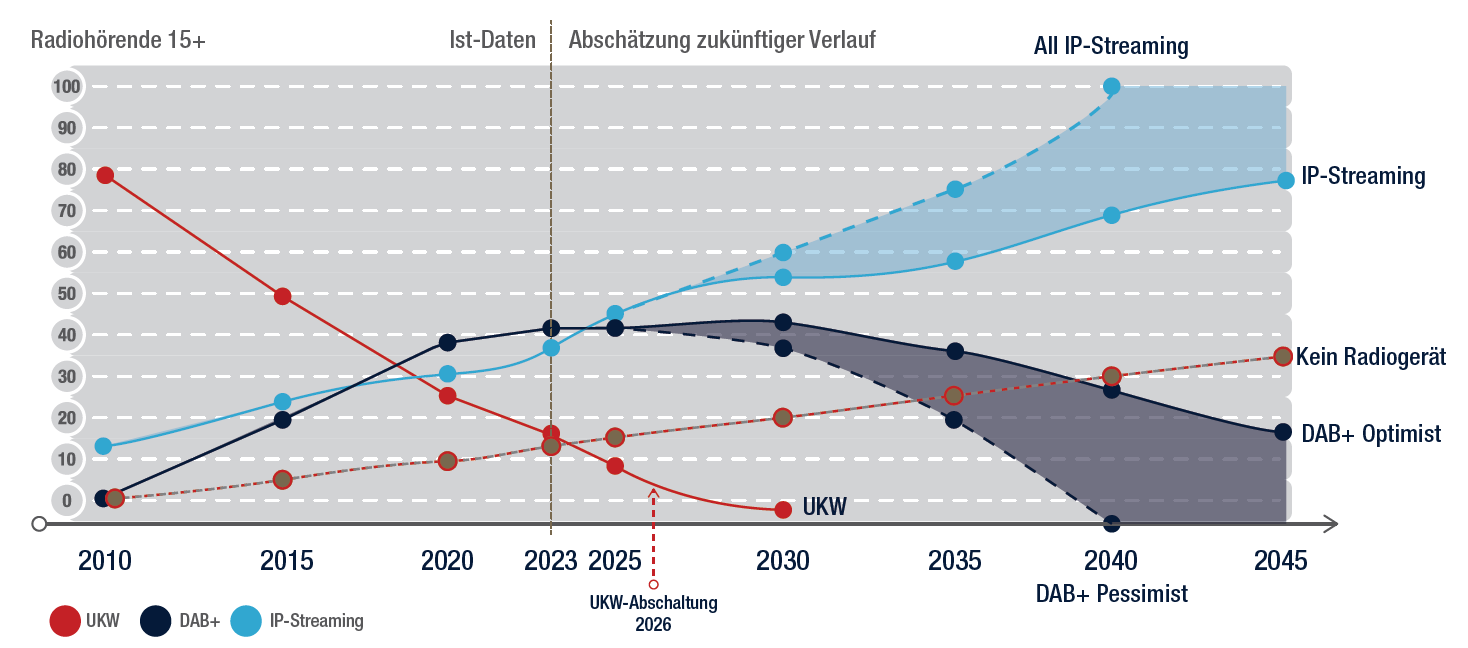Betterrige’s law of headlines stipulates that “any headline that ends with a question mark can be answered by the word NO.” And it is no coincidence that this article’s title ends with a question mark.
I just read an in-depth study (in German 😊) titled “Perspektiven 2035+,” done by the association of Swiss Private Radios. It examines the long-term development potential for radio and audio, especially in terms of distribution.
Long story short, DAB is purely transitional and poised to disappear, and Radio/Audio distribution is heading towards a fully IP-streaming future.
Let’s dive in.
Key Findings from the Study on DAB and Streaming
First of all, radio remains a stable medium with high levels of trust among the public, and its usage remains relatively constant compared to significant declines in other media. But, its audience is both declining and aging.
Swiss radios rely on three main distribution technologies: FM (UKW in German), DAB+, and IP streaming. FM is phasing out in favor of DAB+ and IP, but the transition faces hurdles due to cost and user adoption, very much like everywhere else in Europe.

Credit: Verband Schweizer Privatradios
So, radio faces distribution challenges but also changes in listening habits, with an increasing preference for non-linear audio, such as podcasts and streaming. Younger audiences are leading the shift away from traditional radio to digital platforms.
What we are witnessing here is radio digital transformation.
What are the Implications of Streaming for Audio Publishers and Radio Stations?
The current digital transformation of radio has implications across many blocks of the value chain. Here are – in our view at Audiotiq – the 5 main challenges for publishers. Some are easier to address than others.
-
A Comprehensive Multi-Platform Strategy
Broadcasters must embrace the digital transformation by investing in IP streaming to reach audiences where they are most active—on their smartphones, not their radio receivers. Investing in IP streaming means developing user-friendly apps and platforms to make accessing content easier and more engaging.
This is a massive undertaking as one’s mobile app is compared to the best-in-class UX (User eXperience) and UI (User Interface) such as Spotify, Tinder, Amazon, the neo-banks, Strava, etc.
Practically, audio publishers need to work on a multi-platform distribution strategy:
- Be available on their own properties (mobile apps, websites)
- Collaborate with tech platforms like Spotify, Apple, and Amazon (Alexa) to broaden reach and win new listeners, ultimately attracting those news listeners to their properties.
-
An updated Content Strategy
Audio publishers should also diversify their content offerings. There should be no more one-size-fits-all, which benefits mainstream content. Publishers should expand into non-linear audio formats and on-demand streaming and create diverse, high-quality content that appeals to younger demographics and niche audiences. IP streaming enables personalization at scale, and users expect content to adapt to their preferences.
-
A Mandatory Data Strategy
IP streaming is a two-way communication (compared to one-way broadcasting). That enables a massive leap in data and analytics. Audio publishers should leverage data to understand audience behavior and preferences better. Data must also be used to personalize content recommendations….and ad targeting. Average CPMs are higher on streaming platforms where advertisers can target their audience than on classical radios.
-
A Revised Business Model
Again, IP streaming enables personalization at scale. Targeted advertising is a must. Today’s technology allows great targeting across several dimensions but remains underutilized. How often have you heard an ad on a podcast that wasn’t relevant to you? It could be in the wrong language, the wrong location, or non-pertinent ads.
Exploring new revenue streams like subscription services or content bundles could also yield significant returns.
-
Prepare for further Technological Evolutions
Staying informed about emerging technologies is paramount. This is not over yet, as Generative AI has just proved.
Conclusion and what can Radio Learn from Television?
Audio is heading to a complete IP world, and publishers should prepare for it. As the study highlights, DAB is unlikely to become the dominant audio distribution technology globally or even within Europe in the long term. The shift towards “all-IP” seems inevitable.
Here, Radio can learn from Television. While DVB-T in Europe or ATSC in the US was a hot topic 20 years ago (*), with the introduction of digital terrestrial broadcasting, TV distribution appears to have shifted towards OTT. From state-owned media to Netflix, Amazon Prime, Disney+, or YouTube, Video is mainly distributed via streaming and consumed on-demand, except for a few events such as sports or politics.
As you may have noticed, we no longer use Television; we use Video. I predict we won’t use Radio anymore in the future, but Audio.
(*) Funny enough, at that time, I was involved in the sale and rollout of DVB-T networks and the DRM vs. DAB battle to become the standard for digital audio…
